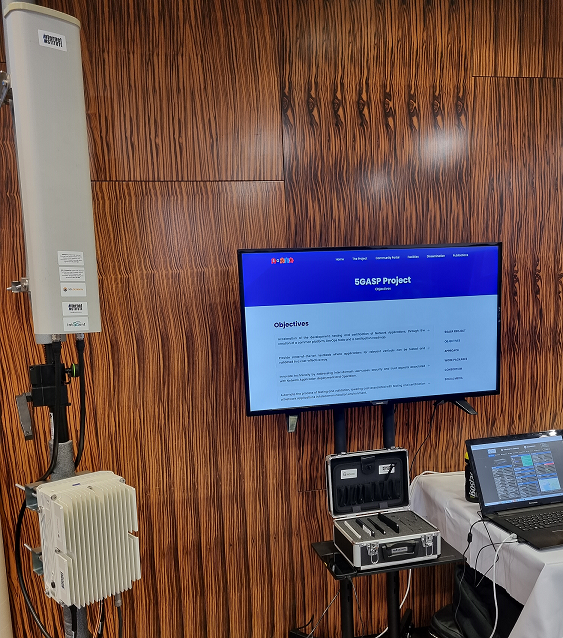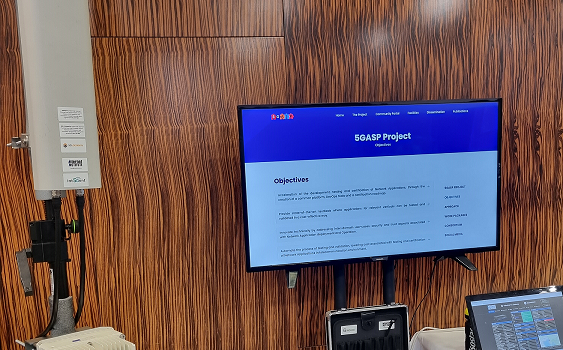
In the blogpost on Assuring 5G PPDR slice in 5GASP environment we discussed how 5GASP concepts are utilized in order to shorten the idea-to-market process by using a fully automated and self-service testbed provided by 5GASP environment. Since the 5GASP approach involves extensive testing of 5G Network Application before deploying it, a few PPDR specific test cases have been developed and implemented as presented in this blog. Although some of the test cases developed and implemented are tightly related to Isolated Operations for Public Safety functionality, the majority of test cases are generic and in general applicable to any PPDR Network Application.
The basic assumption regarding test cases is that the test cases should verify the end-to-end operation over the 5G PPDR-specific slice and its features (in our particular case this would be IOPS), as well, to provide additional end-to-end network performance KPIs.
To meet the above requirements and to test the Network Application as generally as possible, different types of PPDR UE devices should be involved in test cases. Also, PPDR UEs used should offer different levels of capabilities to be able to address multiple variants of the test cases and consequently to identify any dependence of the Network Application feature or performance parameter to the certain UE. Referring to the UEs, we can think of 5G smart phone running Android as one example, and, as another example, 5G industrial gateway running Debian/Ubuntu. These two UE types are therefore explicitly addressed within the test cases; however, anyone can also modify test cases to support any other UE.
PPDR specific test cases already supported by 5GASP environment are as follows:
- PPDR UE (smart phone) – register/attach: this test validates that the smart phone can register and attach in the 5G PPDR network; test can be performed only manually.
- PPDR UE (5G gateway) – register/attach: this test validates that the 5G gateway device can register and attach in the 5G PPDR network; test can be performed automatically.
- non-PPDR UE (5G gateway) – register/attach: this test validates that the non-PPDR 5G UE (gateway) is not allowed to register and attach in the 5G PPDR network; test can be performed automatically.
- PPDR UE (smart phone) – authentication: this test validates that only authenticated 5G UE (smart phone) can register and attach in the 5G PPDR network; test can be performed only manually.
- PPDR UE (5G gateway) – authentication: this test validates that only authenticated 5G UE (gateway) can register and attach in the 5G PPDR network; test can be performed automatically.
- PPDR UE (smart phone) – CHAP: this test validates that PPDR APN is using CHAP authentication when requesting APN from the 5G UE (smart phone); test can be performed only manually.
- PPDR UE (5G gateway) – CHAP: this test validates that PPDR APN is using CHAP authentication when requesting APN from the 5G UE (gateway); test can be performed automatically.
- PPDR UE (smart phone) – PPDR slice: this test validates that only PPDR 5G UE (smart phone) is allowed to use the dedicated PPDR slice); test can be performed only manually.
- PPDR UE (5G gateway) – PPDR slice: this test validates that only PPDR 5G UE (gateway) is allowed to use the dedicated PPDR slice; test can be performed automatically.
- PPDR UE (smart phone) – network connectivity: this test validates that the 5G UE (smart phone) can reach the public services over the PPDR network; test can be performed only manually.
- PPDR UE (5G gateway) – network connectivity: this test validates that the 5G UE (gateway) can reach the public services over the PPDR network; test can be performed automatically.
- PPDR slice – QCI: this test validates that PPDR slice is using correct QCI; test can be performed automatically.
- PPDR slice – minimum DL bitrate: this test validates that PPDR slice is offering the 5G service with the configured minimum DL bitrate for PPDR users; test can be performed automatically.
- PPDR slice – minimum UL bitrate: this test validates that PPDR slice is offering the 5G service with the configured minimum UL bitrate for PPDR users; test can be performed automatically.
Other test cases are related to specific functionality of IOPS, therefore we will only list these tests titles without further stating any specific details: PPDR IOPS – failure detection time, PPDR IOPS – switchover, PPDR IOPS – switchover time, PPDR IOPS – restoration, PPDR IOPS – restoration time, PPDR IOPS – UE attach to IOPS network (smart phone), PPDR IOPS – UE attach to IOPS network (5G gateway), PPDR IOPS – non-PPDR UE attach to IOPS network (5G gateway), PPDR IOPS – UE local IOPS network connectivity (smart phone), PPDR IOPS – UE local IOPS network connectivity (5G gateway), PPDR IOPS – UE attach to PPDR network after restore (smart phone), PPDR IOPS – UE attach to PPDR network after restore (5G gateway).


